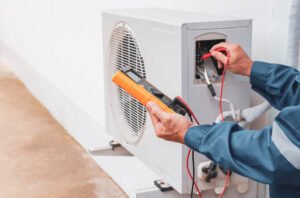When installing an HVAC or refrigeration system, reducing operational noise is a key consideration for comfort and maintaining a peaceful living or working environment. Refrigerant line sets, which connect the outdoor unit to the indoor evaporator coil, significantly mitigate noise. We will explore how refrigerant line sets’ design, installation, and material choices contribute to quieter system operation. Understanding the mechanisms behind this can help homeowners, businesses, and professionals make informed decisions to improve comfort levels in spaces where noise could be a concern.
Contents
Design Considerations for Noise Reduction
The design of refrigerant line sets directly impacts their ability to reduce noise. Line sets typically consist of copper tubing that carries refrigerant between the condenser and the evaporator coil. The design of these lines, including their diameter and insulation, plays a crucial role in minimizing vibrations that can lead to audible sounds. A properly designed refrigerant line set will be securely attached to the building’s framework to prevent excessive movement, which could cause rattling noises. Moreover, line sets insulated with materials such as foam or rubber absorb vibrations and prevent them from propagating through the system. The insulation acts as a barrier, reducing sound transmission and ensuring that the refrigerant lines do not contribute to unnecessary noise.
Choosing the right refrigerant line set, with appropriate dimensions and insulation, can significantly affect the system’s overall noise profile. Line sets that are too thin or improperly insulated may cause the system to emit higher noise levels, either through vibration or by carrying sound through the air. A well-thought-out design, considering factors such as the size of the space and the type of equipment, will help maintain quiet operation, offering a more comfortable atmosphere for occupants.
Installation Practices That Minimize Noise
The way refrigerant line sets are installed can have a substantial impact on system noise levels. Proper installation techniques ensure the lines are securely fastened and insulated, preventing noise transmission. For example, refrigerant lines should be routed away from walls, floors, or other surfaces that could amplify vibrations. Mounting the lines on brackets or using vibration isolation pads can also help mitigate sound transmission. Additionally, ensuring that the lines are not bent at sharp angles can reduce the chance of turbulence or pressure irregularities, which might result in noise.
Another essential consideration during installation is the use of proper supports and hangers. Insufficient support can allow the lines to move, causing noise from friction or vibration. In contrast, secure installation keeps the lines stable, reducing the likelihood of rattling. Furthermore, securing the lines to minimize contact with metal surfaces or hard materials will prevent the reverberation of sound, which can be particularly distracting in quiet environments.
Installation is crucial for the system’s overall functionality and for controlling noise levels. By following the correct installation protocols, HVAC professionals can ensure that refrigerant lines contribute to a quieter environment, enhancing comfort for those in the building.
Materials That Absorb and Reduce Vibration
The materials used for refrigerant line sets can significantly reduce noise. Insulation materials such as rubber or foam are commonly used to coat refrigerant lines because they absorb and dissipate vibrations. Refrigerant moving through the line can cause vibrations that lead to noise if not properly contained. Insulating the lines helps dampen these vibrations before they can escape into the surrounding environment. The insulation also plays a role in temperature regulation, which can further prevent noise caused by condensation or expansion.
Different materials are better suited to specific environments. For instance, rubber-lined insulation provides excellent noise dampening, as rubber absorbs vibration without transferring it. On the other hand, foam insulation can help reduce sound and heat transfer, offering a dual benefit for noise reduction. The combination of insulation and the selection of high-quality materials results in a noticeable decrease in noise levels, ensuring that the refrigerant lines do not add unwanted sound to the operation of the HVAC or refrigeration system.
Additionally, the thickness and density of the insulation material can influence the degree of noise reduction. Thicker insulation tends to be more effective at absorbing sound, especially in environments where noise control is critical. Selecting the appropriate materials and insulation can achieve a quieter system operation, even in larger or more industrial settings.
Refrigerant line sets are essential in minimizing noise in HVAC and refrigeration systems. From the design and installation to the choice of materials used, each factor reduces vibrations and prevents noise from traveling through the system. Proper insulation, secure mounting, and high-quality materials create a quieter system that enhances comfort for building occupants. In addition, these considerations contribute to long-term system performance by reducing wear and preventing mechanical issues that could lead to costly repairs. Ultimately, paying attention to the details of refrigerant line sets can significantly improve the operation and lifespan of HVAC systems, ensuring a quieter and more efficient environment.








